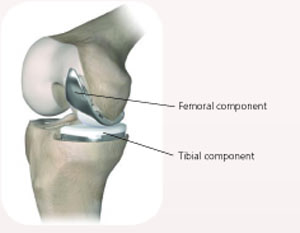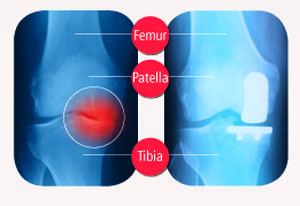Unicompartmental Knee Arthroplasty (UKA)
Description of the knee’s three compartments:
The tibia (leg bone) and femur (thigh bone) meet at the knee and divide into medial (inner) and lateral (outer) tibio-femoral compartments. The patella (kneecap) in the front of the knee articulates with the trochlea (kneecap socket) of the femur to form the patello-femoral compartment. The tibio-femoral compartments are used for walking. The patello-femoral compartment is used for kneeling, squatting and stair-climbing.
Definition of unicompartmental knee arthroplasty:
Unicompartmental knee arthooplasty is when one of the knee’s tibio-femoral compartments, usually the medial one, is resurfaced. Contrast this procedure to total knee arthroplasty (TKA), which resurfaces both of the tibio-femoral compartments and usually the patello-femoral compartment.
Benefits of unicompartmental knee arthroplasty over total knee arthroplasty:
- Recovery Is Faster: Patients walk on unicompartmentals the day of surgery and usually go home the next morning. After total knee arthroplasty (TKA) there is a hospital stay of four days and usually a stay in a skilled nursing facility for a week or more after that.
- Less Pain: Much less post-operative pain medicine is needed with a unicompartmental. This is because the surgery is less extensive, the incision is smaller, and there is less tissue trauma.
- Range Of Motion: Unicompartmentals, on average, provide greater knee flexion than TKAs.
- Greater Feeling Of Normalcy: Patients who have a unicompartmental on one side and TKA on the other generally say that the unicompartmental feels more like a normal knee.
 Better Alternatives When The Prosthesis Wears Out: A primary TKA will usually last 10-20 years. When it fails it must be replaced with a Revision TKA (RTKA). RTKAs have a high complication rate and don’t last as long as primary TKAs. The unicompartmental arthroplasty buys time. When it wears out it is replaced by a TKA. Patients may never need an RTKA or if they do, they generally will have gotten many more years use out of their TKA.
Better Alternatives When The Prosthesis Wears Out: A primary TKA will usually last 10-20 years. When it fails it must be replaced with a Revision TKA (RTKA). RTKAs have a high complication rate and don’t last as long as primary TKAs. The unicompartmental arthroplasty buys time. When it wears out it is replaced by a TKA. Patients may never need an RTKA or if they do, they generally will have gotten many more years use out of their TKA.- No Blood Transfusions: Unicompartmentals rarely if ever need blood transfusions. Blood transfusions are often necessary after TKAs.
Disadvantages:
- Less Proven Reliability: Unicompartmentals sometimes do not sufficiently relieve pain and must be revised to primary TKAs. This initial failure rate is higher for unicompartmentals than for TKAs in many series. Unicompartmental technology is newer and we cannot always tell whether a patient is an appropriate candidate for it.
- Less Proven Durability: Most TKAs and unicompartmentals will last 10 years. However many TKAs will last 15 or even 20 years. We do not have data with modern unicompartmentals showing durability to that degree.
Age as a parameter:
Patients of any age can benefit. Older patients benefit from the reduced severity of the procedure and easier recovery. Younger patients benefit because when the prosthesis eventually fails (all prostheses fail faster in younger patients), they will be able to have it replaced with the better primary TKA as opposed to the less desirable RTKA.
Risks of the procedure:
Infection occurs about 1% of the time and would require further surgery. Fracture of the knee bones at the time of surgery or later has occurred rarely. Blood clots can occur but are very rare. Some patients will have inadequate pain relief and require revision to primary TKA. Others will have relief but still have significant residual discomfort. Stiffness can occur and require further surgery and may not resolve completely. RSD (chronic pain syndrome) can also occur. This list is not exhaustive.
 Candidates for unicompartmentals:
Candidates for unicompartmentals:
- Patients who have severe arthritis of one tibio-femoral compartment (medial OR lateral) but little or no arthritis of the other tibio-femoral compartment. There can be some arthritis of the patello-femoral compartment if it is not severe.
- Patients who localize their arthritis to either the medial or lateral side. Patients whose primary pain is in the front of the knee or throughout the knee are not good candidates.
- Patients who feel that the advantages of unicompartmentals outweigh the fact that the failure rate is currently a little higher than with TKAs.
Composition:
The tibial piece is made of a special plastic. The femoral piece is made of metal.
